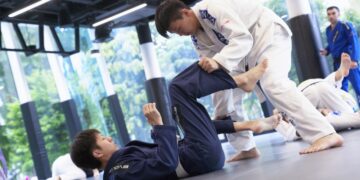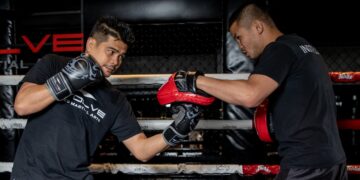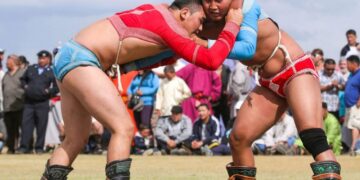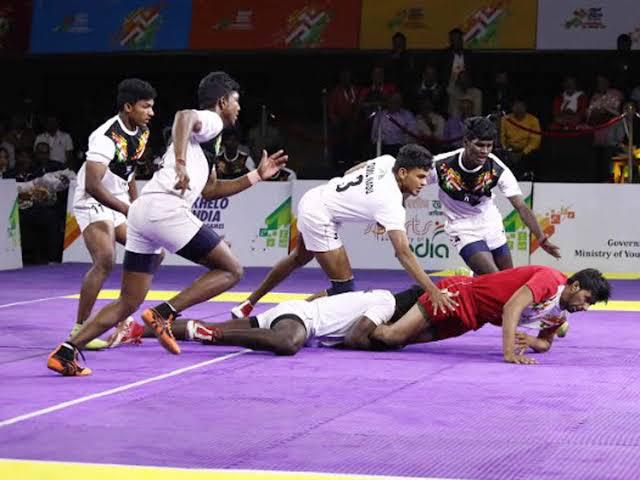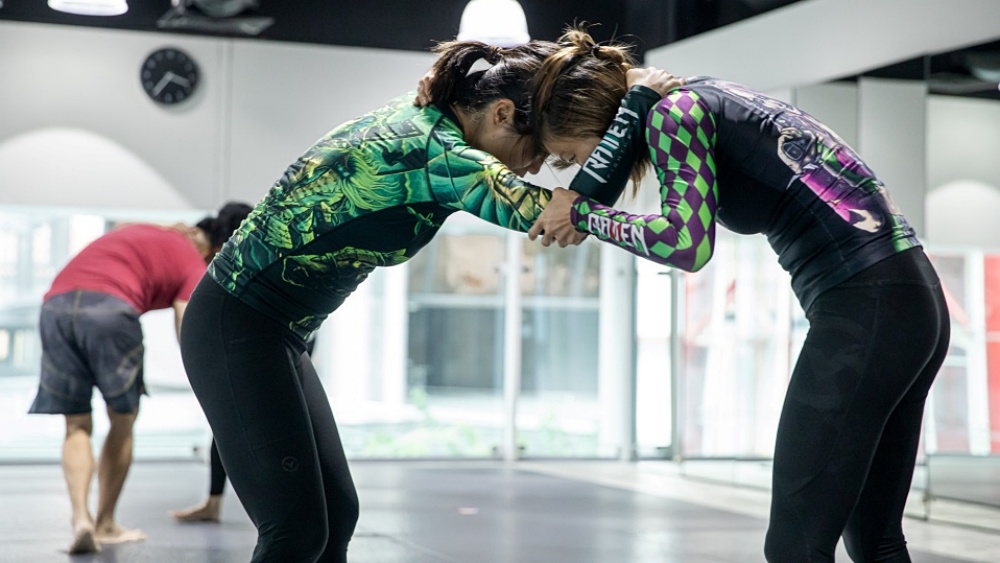
The Muay Thai clinch is one of the most used techniques in striking and can also be used in grappling scenarios like Brazilian Jiu-Jitsu. Like the collar tie in grappling, the Muay Thai clinch can be done with one or two arms; you can also control the opponent’s arms for added control. Typically, it is used in Muay Thai to control the opponent’s head and, therefore, their body, which allows you to create angles and ultimately open the opponent for strikes.
While the full Muay Thai clinch or the double collar tie is illegal in Greco-Roman and Freestyle wrestling, it is legal in grappling matches when done from the stand-up. Today, let’s discuss how Muay Thai clinching can transform your grappling skills.
The Use Of Muay Thai Clinch In Grappling
The Muay Thai clinch has many uses in grappling-oriented situations. While it allows a combatant to set up strikes in a striking match, it is also used to break down the opponent, enter takedowns, or apply different submissions. Below are some ways the Muay Thai clinch can transform your grappling game.
1) Breaking The Opponent’s Posture
As one of the general rules in grappling, controlling the opponent’s head allows you to control their body, thus the saying – wherever the head goes, the body follows. Using the Muay Thai clinch or the collar tie in grappling, you can control the opponent’s head by pulling it down (snap down) from the crown or moving laterally as your forearm blocks their clavicle. Doing so allows you to control the opponent’s head, break their posture, and prevent them from setting up a takedown by grabbing your legs.
A good initial control over the opponent’s head enables you to dictate the pace and set up your go-to takedowns. Remember to stay relaxed to effectively utilize the tie-ups, as holding for too long without committing or setting up an attack is one of the common mistakes grapplers make when doing the collar tie. Holding on to the clinch long enough exposes you to jumping submissions, which the opponents may employ.
2) Entry To The Front Headlock
A strong Muay Thai clinch translates well in grappling, as you can easily drag down the opponent’s head positioning. Rather than using the Muay Thai clinch to pull the head down and land a knee, you can use it in grappling to snap the opponent’s head down and trap it with the front headlock.
To mix things up, you can also use the collar tie to snap down and fake a takedown shot. As the opponent defends from the fake takedown by sprawling, immediately go to the front headlock.
The front headlock has many uses. If you grab the front headlock and the opponent gets back on their feet, you can flip them over to the ground by combining it with the Sumi Gaeshi. On the other hand, if the opponent stays on the ground, you can transition to get their back or apply different submissions like the Anaconda, D’Arce, Guillotine, or the different necktie submission variations.
3) Entry To Takedowns
As mentioned above, a strong Muay Thai clinch or collar tie allows you to manipulate the opponent’s head positioning. Controlling the opponent’s head will enable you to direct the movements on their feet, which you can use to set up your takedowns. Push and pull, disengaging and reengaging, dragging down, and moving side to side are all effective movements you can use to dictate the opponent’s movements in the stand-up using the collar tie or one-arm Muay Thai clinch. Doing this disrupts their balance and enables you to swiftly change level and drive forward without giving the opponent enough time to react.
Some of the common takedowns you can employ from the collar tie are the duck under, which gives you a path to the opponent’s back, the classic single leg, double leg, or a combination of the two, which allows you to get to side control, and the high crotch, which enables you to get behind the opponent or land in side control.
4) Entry To Submissions
A sturdy Muay Thai clinch, or collar tie can be challenging, especially in grappling. Thankfully, we can utilize it to apply submissions on the opponent while in the stand-up. However, remember that having a one-arm collar tie as your other hand controls their bicep or triceps means the opponent can have the same control and pose and expose themselves to the same submission threat as you.
Some of the usual submissions you can perform from the stand-up clinch are the flying armbar, triangle, and guillotine.
5) Stronger Posture
Spending countless hours training the Muay Thai clinch allows you to develop a strong neck and an upright posture. As already mentioned in the points above, a strong posture is critical in grappling. From the stand-up, a strong posture makes it difficult for the opponent to drag you and control your body. However, keeping too upright exposes you to risks, like flying submissions or opponents aiming for a lower-body takedown. On the other hand, maintaining a good posture is critical, especially when passing the guard, and to prevent yourself from getting caught or getting out of submissions.
6) Situational Awareness
Clinching in Muay Thai gives a fighter the self-awareness to safely move in and out of position. In grappling, it allows you to go to various attacks, which can surely help your overall game.
Conclusion
Learning Muay Thai and grappling is among the most deadly hand-to-hand fighting combinations you can do. With the proper guidance, anyone can develop their physical and technical abilities to become a monster on the mats. We encourage you to try this combination and see your game improve drastically.
You may also like:
5 Effective Low-Kick Combinations In Muay Thai
Fabricio Andrey is one of the most exciting Brazilian Jiu-Jitsu grapplers today. The signing of the young Brazilian grappling star paves the way for him to compete on the global stage of ONE Championship against…
The technical mount is one of the most versatile and dominant positions in Brazilian Jiu-Jitsu. From this position, you have control over your opponent’s movement while remaining highly mobile, making it ideal for setting up…
BJJ is a martial art that values both practicality and creativity. While foundational techniques form the core of a solid game, flashy moves can set you apart on the mats. These eye-catching techniques aren’t just…
Recently, BJJ has had its fair share of rising talents showcased in the grappling world. As the sport becomes more prevalent, it also calls for the attention of the younger generation, increasing the number of…
Martial arts are ever-evolving. Thought-provoking ideas, technique development, and the introduction of new rule sets keep them from growing. With Brazilian Jiu-Jitsu being one of the fastest-growing martial arts today, the idea of adding striking…
The technical mount is one of the most dominant positions in Brazilian Jiu-Jitsu. From this position, your opponent can apply a range of submissions and transitions, leaving you with limited options to defend. While it’s…
You’re in the heat of battle during a mixed martial arts (MMA) contest. Your opponent throws hard strikes at you with without caution, giving you plenty of opportunities to land precise counters. But then you…
If you’re new to martial arts in Singapore, you’re probably kicking and boxing almost daily. Why? Because the adrenaline high of sports is very motivating. Endorphins course through your body when you work out, giving…
Balancing a full-time job with your martial arts training sometimes feels like juggling flaming swords while walking a tightrope. However, there are innovative strategies that you can use to balance your training with your job…
A good recovery routine ensures your body is ready for your next martial arts training session. It also lets your body get the most out of all the hard work you put in at the…
Low kicks play an interesting role in Muay Thai. They are powerful, effective, and landing several of them in a round can chip away at both a fighter’s speed and confidence. However, they rarely have…
Martial arts have shaped the world’s military forces for millennia and continue to do so despite the many military technological advancements made in the past few centuries. While the days of battles taking place on…






